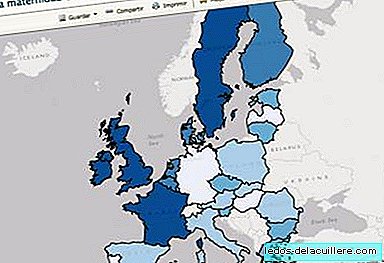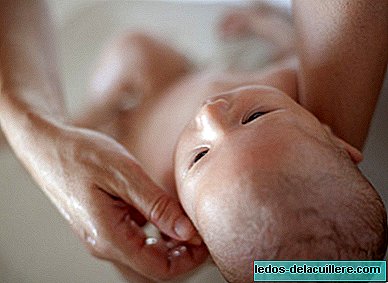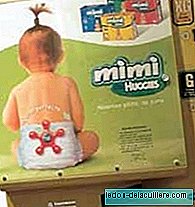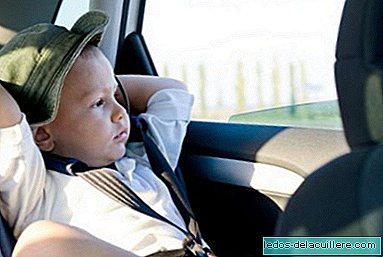
It is important to know our environment and know how motherhood is lived in other countries, to see what works on issues such as conciliation or what makes its inhabitants happier, among others. The Web mujerymapas.com offers us the map of women in figures, showing on a map and with figures the situation of women in Spain and Europe in terms of employment, gender violence or labor conciliation.
We also find information about access to the University or representation in high public positions of women, and there are temporary data that allow us to see its evolution over the last years. We are especially interested in Map of motherhood in Europe, whose data we will expose below.
We have this map of women thanks to Esri Spain, a company specialized in Geographic Information Systems (GIS). The sources to elaborate it come from the public data of the Institute of the Woman, National Institute of Statistics, Eurostat, European Union, Ministry of Education, Culture and Sport and General Council of Judicial Power.
The map is available on the Internet and existing information will be updated, adding content of interest to users. Esri's goal is to offer a platform for quick access to all information regarding women and whose visualization allows us to better understand the current landscape.
Mujerymapas.com uses ArcGIS.com, a platform that allows you to create and share maps in an easy, simple and free way, using existing data and offering the possibility to create your own content.
The map offers the following differentiated main areas:
Reconciliation that reflects the relationship of the number of children per woman and maternity benefits.
Politics in Spain and Europe where salary differences between men and women are perceived.
Gender violence in Spain and Europe offers maps and graphs with data on crimes of gender violence.
Education in Spain and Europe indicates the presence of university women.
Employment in Spain and Europe where wage differences between men and women are reflected.
The map of motherhood in Europe: data
Three fundamental data appear on the maternity map: the number of children per woman, the percentage of single mothers and maternity leave (the time of permission is indicated, how much salary is received during that time and if it can be shared with the father). We will present the figures according to each member country of the European Union.
Spain: 1'40 children per woman; 34'47% of single mothers; 16 weeks at 100% maternity leave (the last 10 can be shared with the father).
Portugal: 1'32 children per woman; 38'12% of single mothers; 120 days at 100% or 150 to 80% maternity leave.
France: 2 children per woman; 53.74% of single mothers; 16 weeks at 100% or 26 weeks if you are the third child of maternity leave.
United Kingdom: 1'94 children per woman; 46.29% of single mothers; First 6 weeks at 90% and up to 44 with the ordinary percentage quoted.
Ireland: 2.07 children per woman; 33.27% of single mothers; 26 weeks of 100% maternity leave (16 can be shared with the father).
Belgium: 1.84 children per woman; 45.71% of single mothers; 15 weeks (1 month at 82% and the rest at 75%).
Netherlands: 1.79 children per woman; 43.28% of single mothers; 16 weeks at 100%.
Luxembourg: 1.59 children per woman; 32.05% of single mothers; 16 weeks at 100%.
Germany: 1.36 children per woman; 32.74% of single mothers; 14 weeks at 100% (six before delivery) + one year at 67% with a cap of 1800 euros.
Denmark: 1.84 children per woman; 46.79% of single mothers; 52 weeks to be distributed among the parents, of which the mother must take at least 18 and the father 2.
Sweden: 1.94 children per woman; 54.41% of single mothers; 480 days of leave shared between father and mother. The first 390 to 80%.
Finland: 1.86 children per woman; 40.88% of single mothers; 15 weeks at 80% + 158 days shared with the father.
Estonia: 1.62 children per woman; 59.16% of single mothers; 20 weeks at 100%.
Latvia: 1.31 children per woman; 43.47% of single mothers; 16 weeks at 100%.
Lithuania: 1.55 children per woman; 27.95% of single mothers; 52 weeks at 100% + 52 weeks at 80%.
Poland: 1.40 children per woman; 20.24% of single mothers; 16-18 weeks at 100%.
Czech Republic: 1.49 children per woman; 38.83% of single mothers; 28 weeks at 70%.
Austria: 1.39 children per woman; 39.35% of single mothers; 16 weeks at 100%.
Slovenia: 1.53 children per woman; 53.62% of single mothers; 15 weeks at 100%.
Italy: 1.41 children per woman; 19.79% of single mothers; 22 weeks at 80%.
Greece: 1.52 children per woman; 6.57% of single mothers; 17 weeks at 100%.
Bulgaria: 1.57 children per woman; 53.43% of single mothers; 2 years maternity leave. The first at 100% and the second minimum wage.
Romania: 1.38 children per woman; 27.97% of single mothers; 18 weeks at 85%.
Hungary: 1.32 children per woman; 40.82% of single mothers; 24 weeks of 100% permission.
Slovakia: 1.41 children per woman; 31.57% of single mothers; 28 weeks at 100%.
Cyprus: 1.51 children per woman; 11.74% of single mothers; 16 weeks maternity leave at 75%.
malt: 1.43 children per woman; 27.37% of single mothers; 14 weeks at 100%.
We look at the longer maternity and paternity leave, those in Sweden, with 480 days (16 months) shared between father and mother receiving 80% up to 390 days. The father has the obligation to take at least 60 days plus 10 working days from birth.
Recall, although it does not appear on the map because it does not belong to the EU, that Norway It is highlighted as the best country to be a mother, with 392 days (56 weeks) at 80% or 322 days (46 weeks) at 100%. The father is entitled to 70 days of help (10 weeks) receiving 100% of his salary. The mother is obliged to take 21 days before delivery and 42 days after delivery, the rest can be shared with the father.
On the opposite side, there are Malta (14 weeks), Slovenia or Belgium with only 105 days of permission.
Surely this data maternity map in Europe They make us a little more aware of our reality, our achievements and shortcomings, and make better decisions about it. Hopefully, although at the moment from our position it will help us to claim what we consider best for our motherhood.
Official Site | ArcGIS, Mujerymapas.com More information | Peques and more In Babies and more | We want to know how men reconcile, They ask for 24-week maternity leave in the European Union, Maternity and paternity leave in Europe












